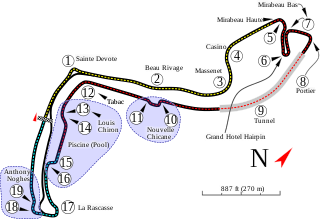
The Monaco Grand Prix is a Formula One motor racing event held annually on the Circuit de Monaco, in late May or early June. Run since 1929, it is widely considered to be one of the most important and prestigious automobile races in the world, and is one of the races—along with the Indianapolis 500 and the 24 Hours of Le Mans—that form the Triple Crown of Motorsport. It is the only Grand Prix that does not adhere to the FIA's mandated 305-kilometre (190-mile) minimum race distance for Formula One races.
Grand Prix motor racing, a form of motorsport competition, has its roots in organised automobile racing that began in France as early as 1894. It quickly evolved from simple road races from one town to the next, to endurance tests for car and driver. Innovation and the drive of competition soon saw speeds exceeding 100 miles per hour (160 km/h), but because early races took place on open roads, accidents occurred frequently, resulting in deaths both of drivers and of spectators. A common abbreviation used for Grand Prix racing is "GP" or "GP racing".

Otto Wilhelm Rudolf Caracciola was a German racing driver. He won the European Drivers' Championship, the pre-1950 equivalent of the modern Formula One World Championship, an unsurpassed three times. He also won the European Hillclimbing Championship three times – twice in sports cars, and once in Grand Prix cars. Caracciola raced for Mercedes-Benz during their original dominating Silver Arrows period, named after the silver colour of the cars, and set speed records for the firm. He was affectionately dubbed Caratsch by the German public, and was known by the title of Regenmeister, or "Rainmaster", for his prowess in wet conditions.

The 1953 Formula One season was the seventh season of the FIA Formula One motor racing. It featured the 4th World Championship of Drivers, which was contested over nine races between 18 January and 13 September 1953. The season also included several non-championship races and a separate East German Championship.

Hermann Albert Lang was a German racing driver who raced motorcycles, Grand Prix cars, and sports cars.
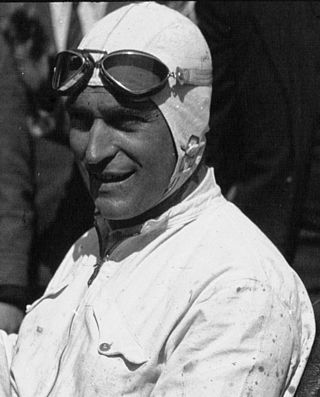
Luigi Cristiano Fagioli was an Italian racing driver, who competed in Grand Prix motor racing from 1928 to 1949, and Formula One from 1950 to 1951. Nicknamed "The Abruzzi Robber", Fagioli won the 1951 French Grand Prix with Alfa Romeo aged 53, and remains the oldest driver to win a Formula One Grand Prix. Fagioli was runner-up in the European Drivers' Championship in 1935 with Mercedes.
The European Drivers' Championship was an annual competition in auto racing that existed prior to the establishment of the Formula One world championship in 1950. It was established in 1931 and ran until the end of 1939 with a hiatus from 1933–34, and awarded points to drivers based on the results of selected Grand Prix races, the so-called Grandes Épreuves. The championship was discontinued because of the outbreak of World War II in 1939, and no champion was officially declared for the last season.

The Mercedes-Benz W125 was a Grand Prix racing car produced by German auto manufacturer Mercedes-Benz to race during the 1937 Grand Prix season. Designed by head designer Rudolf Uhlenhaut, the car was used by Rudolf Caracciola to win the 1937 European Championship and W125 drivers also finished in the second, third and fourth positions in the championship.

Richard John Beattie Seaman was a British racing driver. He drove for the Mercedes-Benz team from 1937 to 1939 in the Mercedes-Benz W125 and W154 cars, winning the 1938 German Grand Prix. He died of his injuries after his car overturned at the 1939 Belgian Grand Prix.
The 1937 Grand Prix season was the fifth AIACR European Championship season. The championship was won by Rudolf Caracciola, driving for the Mercedes-Benz team. Caracciola won three of the five events that counted towards the championship.

Hermann Paul Müller was a German sidecar, motorcycle, and race car driver.
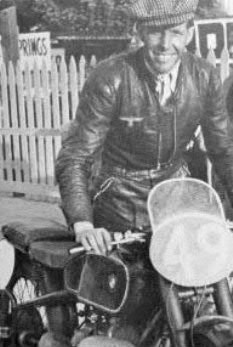
Georg "Schorsch" Meier was a German motorcycle racer famous for being the first foreign winner of the prestigious Senior TT, the Blue Riband race of the Isle of Man TT Races, in 1939 riding for the factory BMW team and the first motorcycle racer to lap a Grand Prix course at over 100 mph.

The 1935 Grand Prix season was the second year of the new 750 kg Formula. The success of the previous year encouraged the AIACR to reinitiate the European Championship. It was composed of the seven national Grands Prix and was won by Rudolf Caracciola, driving for the Mercedes-Benz team. The team dominated the season winning five of those Grand Épreuves, as well as four of the other major races of the season. However, in one of the great motor-races in sporting history, Tazio Nuvolari in a Scuderia Ferrari Alfa Romeo beat the combined numbers of the German teams in their home Grand Prix. The season also saw the arrival on the international stage of the bright young talent Bernd Rosemeyer in the Auto Union team.

The 1931 Grand Prix season was a watershed year, with the advent of the AIACR European Championship. After several years of Grand Prix racing in the doldrums with little technical development, 1931 saw new models come from all three main manufacturers: Bugatti, Maserati and Alfa Romeo.
The World Manufacturers' Championship, also known as Automobile World Championship, was a competition organised by the AIACR between 1925 and 1930. It was the first World Championship in a motorsport.
The 1938 Grand Prix season was the sixth AIACR European Championship season. The championship was won by Rudolf Caracciola, driving for the Mercedes-Benz team. Caracciola won one of the four events that counted towards the championship.
The 1925 Grand Prix season was the first year for the new AIACR World Manufacturers' Championship season. The championship was won by Alfa Romeo, with its P2 model.
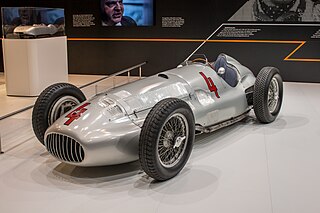
The Mercedes-Benz W154 was a Grand Prix racing car designed by Rudolf Uhlenhaut. The W154 competed in the 1938 and 1939 Grand Prix seasons and was used by Rudolf Caracciola to win the 1938 European Championship.

The 1926 San Sebastián Grand Prix was a Grand Prix motor race held at Circuito Lasarte on 18 July 1926. It was also designated as the European Grand Prix.
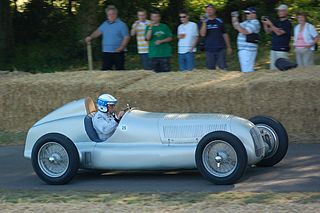
The Mercedes-Benz W25 was a Grand Prix racing car designed by Daimler-Benz AG for the 1934 Grand Prix season, in which new rules were introduced, and no championship was held. In 1935, the European Championship was resumed, and it was won by Rudolf Caracciola in a W25. In modified form, the W25 remained in use until 1937, when it was succeeded by the Mercedes-Benz W125.














